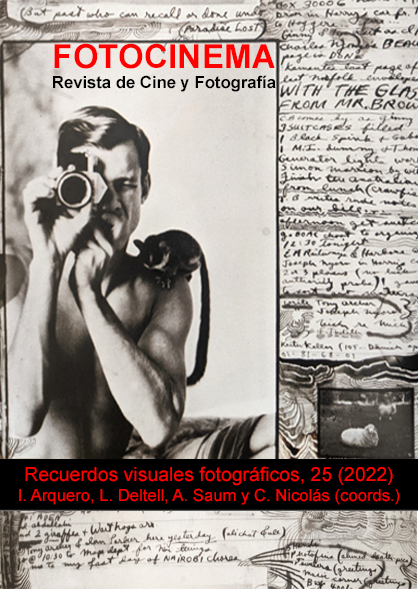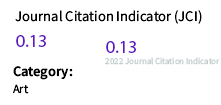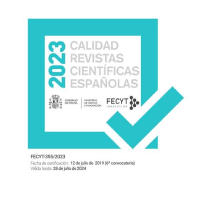Reflections and aesthetic exercises around the visualisation and dynamisation of photographs: creating visual memories from photographic images
DOI:
https://doi.org/10.24310/Fotocinema.2022.vi25.14444Keywords:
Photographic images, Interpretation and visual reading, Dynamisation, Audiovisual products, Objectivity and subjectivity, Visual memoriesAbstract
We start from the idea that the photographic image connects objective reality and the subjective world. This idea has been extensively elaborated in the field of the Theories of Photography and Cinematography, such as Siegfried Kracauer, Edgar Morin, Roland Barthes and other authors, as well as in some of the experiences of the film director Agnès Varda. Thus, through the application of various mental and technical devices - smartphone cameras - we proposed and carried out a sequence of practical experiments in relation to the reading, observation and dynamisation of some of the author's photographs. The results yield interesting insights into the emergence of new personal and narrative interpretations, beyond the reality captured objectively and mechanically by the camera. These results take the form of various audiovisual pieces, one of which is included here. The latter constitute in themselves new creations and aesthetic attitudes which, despite being related, are situated on the margins of the original work.
Downloads
Metrics
References
Ackermann, E., y Wodiczko, K. (1999). In conversation. Thresholds, 19, 57-63. Recuperado de https://www.jstor.org/stable/43876052
Aumont, J. (1992). La imagen. Paidós.
Barthes, R. (1986). Lo obvio y lo obtuso. Imágenes, gestos, voces. Paidós.
Barthes, R. (1990). La cámara lúcida. Nota sobre la fotografía. Paidós.
Berger, John y Mohr, J. (1982). Another way or telling. Pantheon.
Bordieu, P. (2003). Un arte medio. Gustavo Gili.
Casetti, F. (1994). Teorías del Cine. Cátedra.
Clemmen, Y. W. A. (1997). Anny Duperey: The silence of photography. Romanic Review, 88(4), 591-605.
Conde, A. (2008). La precisión de la nada (reflexiones sobre Blow Up). Cuadernos de Filología Italiana, 15, 157-179. Recuperado de https://bit.ly/3vYW5Ku
Decock, J. (1993). Entretien avec Agnès Varda sur Jacquot de Nantes. The French Review, 66(6), 947-958. Recuperado de https://www.jstor.org/stable/397507
Dubois, P. (1986). El acto fotográfico. De la representación a la Recepción. Paidós.
Dufrenne, M. (1982). Fenomenología de la experiencia estética. Fernando Torres.
Espinosa, O. (2011). La infancia del cine, una revisión de la teoría cinematográfica de Siegfried Kracacuer. Historia y grafía, 36, 41-77. https://doi.org/10.48102/hyg.vi36.319
Fiedler, J., y Feierabend, P. (2000). Bauhaus. Konemann.
Kracauer, S. (1989). Teoría del cine. La redención de la realidad física. Paidós.
Krauss, R. (1984). A note on Photography and the Simulacral. October, 31, 49-68. Recuperado de https://www.jstor.org/stable/778356
Krauss, R. (2002). Lo fotográfico. Por una teoría de los desplazamientos. Gustavo Gili.
Laplantine, F. (2007). Penser en images. Ethnologie française, 37(1), 47-56. Recuperado de https://www.jstor.org/stable/40991023
Lenzi, T. (2009). La fotografía contemporánea como dispositivo discursivo y/o narrativo. Revista Digital do LAV, 2(3), 121-146. Recuperado de https://bit.ly/3tN5aU7
Moholy-Nagy, L. (1947a). The new Vision and Abstract of an Artist. Wittenborn.
Moholy-Nagy, L. (1947b). Vision in motion. Theobold.
Morin, E. (2001). El cine o el hombre imaginario. Paidós.
Negreiro, T. (2016). Ulisses (1982) e a fotografia no cinema de Agnès Varda. Imagofagia. Revista de la Asociación Argentina de Estudios de Cine y Audiovisual, 14, 1-18. Recuperado de https://bit.ly/3hVQSLp
Rancière, J. (2010). El espectador emancipado. Manantial.
Stam, R. (2000). Film theory: an introduction. Blackwell Publishers.
Vásquez, A. (2011). El ensayo fotográfico, otra manera de narrar. Quórum Académico, 8(16), 301-314. Recuperado de https://bit.ly/3J1HFNb
Viñuela, E. (2010). Del texto escrito al lenguaje audiovisual: la construcción de la Historia a través de historias en Smoke. Revista F@aro, 12, pp. 1-11. Recuperado de https://bit.ly/37412qU
Downloads
Published
How to Cite
Issue
Section
License
All contents published in Fotocinema Revista científica de cine y fotografía are protected under the Creative Commons Attribution-NonCommercial-ShareAlike 4.0 International (CC BY-NC-SA 4.0) license. All about this license is available in the following link: <http://creativecommons.org/licenses/by-nc-sa/4.0>
Users can copy, use, redistribute, share and exhibit publicly as long as:
- The original source and authorship of the material are cited (Journal, Publisher and URL of the work).
- It is not used for comercial purposes.
- The existence of the license and its especifications are mentioned.
There are two sets of authors’ rights: moral and property rights. Moral rights are perpetual prerogatives, unrenounceable, not-transferable, unalienable, imprescriptible and inembargable. According to authors’ rights legislation, Fotocinema. Revista científica de cine y fotografía recognizes and respects authors moral rights, as well as the ownership of property rights, which will be transferred to University of Malaga in open access. The property rights are referred to the benefits that are gained by the use or the dissemination of works. Fotocinema. Revista científica de cine y fotografía is published in an open access form and it is exclusively licenced by any means for doing or authorising distribution, dissemination, reproduction, , adaptation, translation or arrangement of works.
Authors are responsable for obtaining the necessary permission to use copyrighted images.










.png)

13.png)




